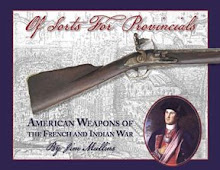Tues March 20, 1759
Petition of sundry Justices of the County of Prince William, setting forth, that they lately imported for the Use of the Militia of their Country (besides 100 Guns) 100 Pair of Highland Pistols, which they judged would be very serviceable in Action, though they were not required by the Law then subsisting, describing the particular Sort of Arms the Militia was to be provided with, of which Law they were then not acquainted, as the same had never been published amonst them, and praying the the said Pistols may be received in the pubblic Magazine, ans such other Relief be granted as shall be thought reasonable.
Prince William County likely needed to spend a bit for arms judging from a letter in the Washington papers the year prior.
George Washington
19th June, 1758 Fort Loudoun,
Fort Loudoun, 19th June, 1758.
Honble. Sir,
The letter herewith enclosed woud have been sent according to the date, but I have been waiting ’till now for Capt. Rutherford’s pay-roll; his company being much dispersed in the Ranging Service.
This day the Prince William Militia are to march for the South-Branch, to relieve two companies of my [38] Regiment, agreeably to orders—Enclosed is a return of their present strength. I should think myself deficient in duty, were I to pass over in silence the conduct and state of this company from
their first coming out—about the 20th ultimo—until the present moment.One hundred Militia were ordered from Prince William County, (but at what time I can not exactly say), by Mr. President Blair. Instead of that number 73 only came: and every one of them unprovided with arms and ammunition, as the Law directs; by which means they were not only useless, but really burthen
some to the Country; as they were eating its Provisions and had their pay running on. This matter was represented to Colo. Henry Lee, Lieutenant of that county, by Sir John St. Clair, then commanding officer here. The consequence of this representation was, that about the 1st of this instant, near 100 arms were sent up by his order; out of which number scarce five were serviceable, and not more than 30 coud be made to fire. This was also represented to Colo: Lee, who, after expressing his concern for it, said, the County expected arms from England every day, and has taken no farther notice of the matter since, that I have yet heard. I immediately set Smiths to repairing their arms, and have, with the assistance of 35 old muskets, which I caused to be delivered out of the Store here, got this company, which ought to have consisted of 100 men (tho’ there are but 68) at last completed.’Till this time they have been a dead expence to the Public, and of no service to the inhabitants. This, [39] Sir, is a true statement of Facts, and really merits reprehension: for, if such Behavior is suffered to escape unnoticed, the most destructive consequences may accrue. In the present case: if the Troops had marched agreeable to the orders I at first received, the companies on the South-Branch would have been drawn off, and the inhabitants thereby left destitute of support; or must have come off with them which it seems they were determined to do. This I understand actually did happen in Augusta County, when Major Lewis came from thence, by the negligence (I suppose) of the County-Lieutenants. I am, &c.1


